 For examples of the 2 most common templates for developing characters I wrote about earlier in Characters in Action-Driven Novels and Those in Character-Driven Stories, I turn to the movies.
For examples of the 2 most common templates for developing characters I wrote about earlier in Characters in Action-Driven Novels and Those in Character-Driven Stories, I turn to the movies.
A few nights ago, engrossed in The Hundred-Foot Journey directed by Lasse Hallström from a screenplay written by Steven Knight and adapted from Richard C. Morais’ 2010 novel The Hundred-Foot Journey, I was struck how perfectly Hassan exemplifies the character-driven profile while Papa Kadam assertively personifies the action-driven profile.
2 Classic Character Types
1) Reflective of a character-driven character profile
Hassan, before moving on when faced with failure / challenges / obstacles :
- Slows down
- Reflect how he’s doing while being sensitive to others
- Evaluates his behavior and reactions
- Examines at what went wrong from all angles
- Learns from his mistakes
2) Reflective of an action-driven character profile
Papa Kadam, on the other hand, classically impulsive and, when faced with failure / challenges / obstacles (until the very end):
- Doesn’t stop to evaluate what went wrong
- Thinks less
- Acts / reacts faster
- Multi-tasks
- Focuses on the achieving the goal not how his behavior affects others
For all the steps how to plot and write the rough draft of a story,
join me as I re-film the
27-Step Tutorial: How Do I Plot a Novel, Memoir, Screenplay?

 Plot Whisperer Martha Alderson’s PlotWriMo: Revise Your Novel in a Month with Literary Agent Jill Corcoran
Plot Whisperer Martha Alderson’s PlotWriMo: Revise Your Novel in a Month with Literary Agent Jill Corcoran
Follow Me!